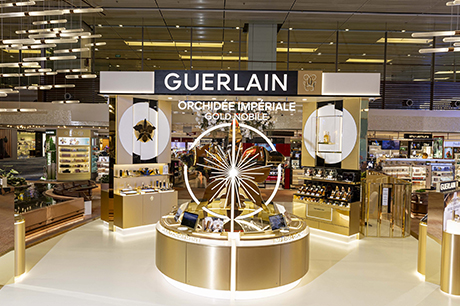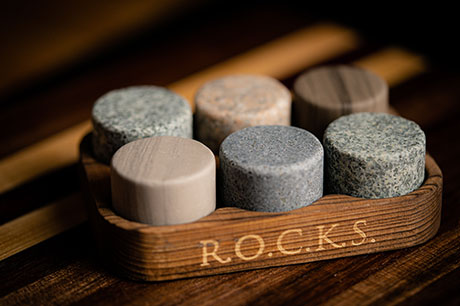Exclusive interview: Nathalie Helloin-Kamel, Fragrance Foundation France
By Michael Barrett |
 Nathalie Helloin-Kamel is Board Member of the Fragrance Foundation France (FFF) and Senior Vice President at Takasago.
Nathalie Helloin-Kamel is Board Member of the Fragrance Foundation France (FFF) and Senior Vice President at Takasago.
She took part in the inaugural Travel Retail Sustainability Week webinar programme, where she presented insights from the Foundation’s annual consumer insights study in the Beautiful Future session. The study revealed how fragrance shoppers are increasingly discerning about the environmental and sustainable values of the brands they purchase.
In an exclusive interview, Helloin-Kamel talks to TRBusiness about the work of the Fragrance Foundation France, her vision for the development of the fragrance sector and the importance of sustainability in the category.
 Helloin-Kamel’s longstanding experience with some of the world’s leading fragrance houses including Hermès Parfums, L’Oréal, Beauté Prestige International and Shiseido, before joining Takasago has established her as a global authority on the art of perfumery and olfactory development.
Helloin-Kamel’s longstanding experience with some of the world’s leading fragrance houses including Hermès Parfums, L’Oréal, Beauté Prestige International and Shiseido, before joining Takasago has established her as a global authority on the art of perfumery and olfactory development.
At Hermès Parfums, she defined the operational, product and brand image strategy of the heritage house and led the relaunch of the legendary Eau d’Orange Verte.
At Beauté Prestige International she was charged with creating perfume brands for fashion houses, while at Shiseido, Helloin-Kamel took on global responsibility for the group’s fine fragrance category, from creation to go-to-market.
Currently at Takasago, she is drawing on her expertise to lead a Parisian team of renowned creators, with her eyes firmly set on tomorrow’s markets: India and China.
When was the French Fragrance Foundation founded, by whom and what are its main missions?
Helloin-Kamel: The French entity of the Fragrance Foundation was created in 1992 by Catherine Disdet, Michèle Meyer and Marie Chantal Fournier, three professionals of the French perfume world. This non-profit association aims to promote the entire perfume industry.
Its missions are to promote the know-how and talents of the industry, bring together professionals, share the passion of perfume, make people dream and inform the general public.
How do you accomplish these missions?
Helloin-Kamel: We have a permanent in-house team with communication and influence professionals who create content and help the industry spread it’s innovations. We have regular newsletters sent to the general public and to the industry and are present on all the main social networks. Each week, we initiate talks with fragrance and perfume leaders or niche brands and also hold a monthly podcast with a key personality, artist, perfumer, cook or insider.
Every year, we hold the Foundation’s awards, which are the equivalent to the Oscars of the perfume industry. It is a very important event, attended by 600 professionals each year. Last year we digitalised it, due to Covid-19 restrictions, and increased the number of people we usually target by tenfold. It was a great success. Our main challenge it to adapt to change in an industry that’s one of the most important and oldest in France.

The 18 trophies handed out at the Fragrance Foundation France’s annual industry awards ceremony.
Although it is a French foundation is membership open to any international company or French companies only? Does the membership extend to partner companies such as bottle and packaging manufacturers and fragrance retailers?
Helloin-Kamel: Yes of course. We are very open and multicultural in our approach. Our strategy is to think of the industry as a whole, in its entirety. So yes, our members include all companies in the business, packaging, glass, sampling industries, as well as those present in services and retailers, or pure digital actors.
Does the Barometer study you conduct gauge consumer insights from France alone or does it also cover international consumers? If not, is this in the pipeline?
Helloin-Kamel: For the moment, the barometer covers just France, but we proposed it to our European colleagues. It is a process in the making.
While France is home to many of the world’s leading Fragrance brands, are you seeing growth in other markets as source markets for fragrance?
Helloin-Kamel: It’s no surprise that an important part of the future of growth in the industry lies with China. In 10 years, China will be the second perfume market in the world and in 20 years it will be the first. India is also a market with a strong perfume culture and no doubt the development of the middle class will make it a big reservoir of growth for the future. Brazil also remains a market with great potential.
What new trends are you observing in the Fragrance market — whether in terms of ingredients, manufacturing process, or consumer trends?
Helloin-Kamel: A revolution is under way. A green revolution, both intimate and universal, which is infusing discourses and practices. The fragrance industry takes full part in this change by constantly redefining its values in response to a clientele whose knowledge and demands have radically evolved, up to a certain skepticism.
For our clients, returning to our roots is a cause for hope. For them, nature crystallises contemporary aspirations to purity, well-being and the respect of the world that surrounds us.
In their quest for a new form of legitimacy, the evolving contours of this notion trace the future of perfumery and of beauty. An ever-increasing demand for natural, clean beauty has moved established brands to reconsider their catalogue as well as their storytelling and allowed the emergence of new players and products as tomorrow’s potential market leaders.
Within this sensibility, the consumers’ approach tends to be towards a certain minimalism, focusing on compositions with high-quality, short formulas, symbolising a return to basics.
In the interest of transparency, brands, long accused of remaining vague about their compositions, have started opening their formulas and communicating on the utility, origin, and impact of each ingredient. In this uncompromising quest for nature, the proportion of natural ingredients has increased dramatically, sometimes making up to 100% of the formula.
The sourcing and traceability of ingredients have also become powerful levers for these companies. In addition, the rarity and purity of a material and its certified provenance bring high added value for the consumer.

Extracts from the FFF’s Perfume sector “Barometer” were shared during the inaugural Travel Retail Sustainability Week webinar programme.
Indeed, why choose? Far from being opposites, the two fields are closely connected. Some innovative young brands have chosen to bank on synthetics in response to the allergenic character of numerous natural materials, putting forward components that are often little known by the public, pure and adapted to the most sensitive skins.
In fine fragrance, synthetic materials — true odes to creativity — played their part in the heyday of modern perfumery and are now increasingly showcased. This is an approach that often requires educating the consumer and that stems from a genuine commitment to limiting the consumption of natural resources.
Science, the limits of which are constantly expanding, is therefore in the service of nature. Green tech (headspace, green chemistry based on renewable natural resources, biotechnology) is a powerful means to preserve it.

Nathalie Helloin-Kamel, alongside perfume designers Christine Nagel (right from centre) and Francis Kurkdjian at the 20th edition of the FFF Awards.
In what ways has the Fragrance industry adopted more sustainable business practices in recent years and how are consumers responding to these developments?
Helloin-Kamel: The fragrance industry on the supplier side and brand side are taking part in this new green revolution. Brand wise, we can note a number of major brand initiatives:
Chanel with mission 1.5°. This has resulted in the brand being carbon neutral since 2019 through carbon footprint compensation.
Dior through project Life 360°. This revolved around a partnership with UNESCO to protect biodiversity, fight against climate change and share concrete actions.
Guerlain with the Bee Project.
Giorgio Armani with the Aqua For Life challenge. Aqua For Life is the Armani programme to create systems for providing drinking water around the world.
Also at Armani, there is the My Way program, where eco-conception is at the heart of the project. This involves a refillable, recyclable, reusable perfume bottle, ingredients from responsible sources, social programmes (with the Fanamby NGO in Madagascar, vegetal alcohol and Carbon Neutrality though reforestation programmes).
Yves Saint Laurent with the “care, collaborate, create” initiative following the 2025 Kering sustainable programs and Saint Laurent Beauté with the “En Avant Toutes” association and the “Aimer Sans Abuser” programme to fight violence in married couples.
Idole Lancôme with sustainable sourcing, involving raw materials from the Lancôme Solidarity Sourcing programme and their perfume bottle innovation — a refillable bottle with a fountain in stores.
CK Everyone and its Clear Formula. This involves vegan ingredients comprising 79% natural ingredients, natural alcohol and organic essential oils. There is also the the CK eco- designed bottle with a screw-cap to create an entirely recycled perfume bottle, designed to be reused by consumers and allow them to be creative.
Thierry Mugler with the fountain and up-cycled rose for Angel Nova.
Girl Rochas with its radical transparency involving the origin of raw materials, components and manufacturing process. There is also the eco-designed bottle with 40% made from recycled glass, eco-responsible lacquering (solvent replaced by water) and a cap made from 40% recycled plastic.
In terms of beauty and fragrance products, there are more and more sustainable initiatives. Consumers answer positively. The trend was accelerated by the pandemic. Now more than ever, people believe they can make a change through their every-day actions. The idea of purpose over profit is making its way. The new sustainability trend is based on a more holistic approach that aims to create social, environmental and economic value. Transparency above all is the new holy grail.

Are you seeing an increasing demand among consumers for more sustainably sourced and packaged fragrance products?
Helloin-Kamel: Yes definitely. The majority of the new projects have a sustainable part in their story. Every element of the mix can contribute to the sustainability and social responsibility of the global project. This is not only for raw materials, but for primary and secondary packaging components. Manufacturing processes have also become more eco-friendly regarding waste, water and electricity consumption.
Can you please tell us a little more about yourself?
Helloin-Kamel: As we say, I’m a seasoned professional in the world of fragrance! I joined the cosmetic and fragrance business 35 years ago. Business wise, I have 2 passions: perfumes, and brands.
I have one mission: understanding my clients’ dreams and expectations and translating them into fragrance. As Senior Vice President of Takasago since October 2017, I manage the Fine Fragrance division at global level.
Before that, I was working on the brand side (L’Oréal, Hermès Parfums, Shiseido/BPI) for more than 30 years. I had the chance to enjoy a unique experience: creating and building four new fragrance brands at international level.
I also had the good fortune to work with exceptional artists and brands: Issey Miyake, Narciso Rodriguez, Elie Saab, Azzedine Alaïa, Zadig & Voltaire and Dolce & Gabbana.
TR Consumer Forum: Agenda & speakers revealed
Influential speakers will unpack the most effective strategies for understanding and engaging...
Saudia Arabia's KKIA unfurls T3 duty free expansion
King Khalid International Airport (KKIA) has unveiled the first stage of its much-vaunted duty...
OUT NOW: March/April Leading Americas Operators
The TRBusiness March/April 2024 edition boasting the inimitable leading Americas Operators...

In the Magazine
TRBusiness Magazine is free to access. Read the latest issue now.

 Trbusiness. The travel retail Trbusiness. The magazine for global retail and duty free professionals.
Trbusiness. The travel retail Trbusiness. The magazine for global retail and duty free professionals.





















